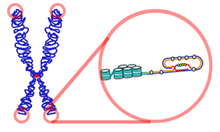Ring Chromosome 15

Ring chromosome 15 (sometimes denoted as r15) is a condition that arises when chromosome 15 fuses to form a ring chromosome. Usually, r15 forms due to modifications or deletion of genes on chromosome 15 in the preliminary stages of embryonic development but it can rarely also be inherited.
If the ends of the chromosome fuse with no loss of genetic material, the individual retains the normal phenotype with relatively slight difference. However, when there is deletion of genetic information at the distal unstable ends where the subtelomeric structures fuse, syndromes associated with that particular chromosome arise. All chromosomes have the capacity to form such rings; the symptoms and severity depend on the amount of the genetic information lost. Thus, the treatment for r15 predominantly targets the eradication of these symptoms rather than the chromosome ring itself.
Presentation

As the cases reported are few in number, and the phenotype expression for ring chromosome 15 syndrome occurs over a wider spectrum; the cells of patients could have different levels of mosaicism.
Ring chromosome 15 is associated with growth delay due to insulin-like growth factor I resistance.
Common features include growth delay, mental retardation and congenital malformation.
Of 25 studies examined by Butler MG, all cases reported growth deficiency, 95% of cases showed varied levels of mental retardation, and 88% of the patients showed microcephaly. Besides those top 3 symptoms that are found most frequently, other symptoms include: Delayed bone age (7%), Hypertelorism (46%), Brachydactyly (44%), Triangular face (42%), Speech delay (39%), Frontal bossing (36%), Anomalous ear (30%), Café-au-lait spots (30%), Cryptorchidism (30%) and Cardiac abnormalities (30%).
A precise, concrete genotype-phenotype association hasn't been established. Research into the condition attempts to elucidate the causes of symptoms. For example, by applying FISH analysis, it was revealed that growth retardation (the most common phenotype) might be caused by terminal deletion of 15q26 (a specific region on the chromosome 15 long-arm).
Mechanism
The human body stores its genetic material in chromosomes. The number of chromosomes and the gene locus on the chromosome is unique to each species. Humans have 23 pairs of chromosomes, 22 pairs of autosomal chromosomes and 1 pair of sex chromosomes that differentiate between males and females.All human chromosomes have 2 arms - the p(short) and the q(long) arm, which are separated by the centromeres.

There are two proposed mechanisms of forming the ring chromosome. One suggests that the chromosome 15 undergoes distortion on both p and q arms prior to the fusion of two broken arms, resulting great loss of genetic materials. Therefore, the patients of this type of r15 display severe clinical features.
The other proposed mechanism suggests the direct fusion of two telomeres without losing any of the telomeric and subtelomeric sequences. Consequently, most of the genetic material is conserved and symptoms are expressed in a milder form, making diagnosis more difficult.
Diagnosis

In most cases, postnatal diagnosis is done and up to 2011, only four cases are reported via prenatal diagnosis. Congenital diaphragmatic hernia and intrauterine growth retardation (these two signs put the patients at the risk of afflicting with r15) by fetal ultrasound (Obstetric ultrasonography) at the time period of 16-24 weeks, further investigation and diagnostics (such as karyotyping) must be performed to test the possibility of ring chromosome 15.
Postnatal diagnosis
Patients could be considered to have ring chromosome 15 if they are found with:growth deficiency, café-au-lait spots, bone age delay and simian crease or other dysmorphic features after birth.
Management
Treatment of the disease is based on alleviating symptoms.
Epidemiology
Ring chromosome syndromes are rare congenital disorders that are likely to occur in both males and females, and the symptoms can be observed from birth since it arises during the embryonic stage. All races and ethnicities are prone to the disorders and the risk can be higher if the parents are carriers since it is genetically inherited.
Any of the 23 pairs of chromosomes can be ringed, and a recent study conducted by the 'Human Ring Chromosome Registry' in China revealed that the more frequent forms of ring chromosomes reported were 13, 15, 18 and 22.
History
r15 is an uncommon genetic disorder first noted by Dr Petrea Jacobsen in 1966. To date, around 40 cases have been reported.